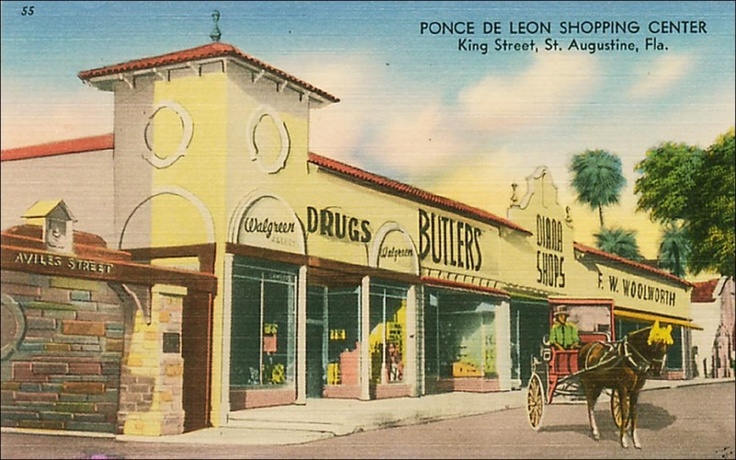By Amanda Kraus | gargoyle@flagler.edu
As the “Oldest City in America,” St. Augustine’s history is vast, covering generations upon generations. Tour guides and museums try to cover everything as best they can. However, one part of the city’s history seems to be hidden from plain sight: its role in the Civil Rights Movement.
St. Augustine didn’t have the best reputation during the Civil Rights Movement– it was the only town in the state of Florida where Dr. Martin Luther King was arrested, and has a prominent, and extremely violent Ku Klux Klan presence well beyond the Civil Rights era.
Regardless of whether the city’s role was positive or negative, it should still be acknowledged. Since February is Black History Month, why not help shed light on some St. Augustine history we may not have heard on the trolley ride?
Wells Fargo: Woolworth sit in

Depicted in the postcard above is a strip mall containing a Woolworth department store at the far right of the photo where the Wells Fargo bank is now located on King Street across from the Plaza de la Constitucion, St. Augustine square, and gazebo park.

Woolworth department stores were infamous during the Civil Rights Movement for their lunch counter sit-ins, started by college students in Greensboro. These sit-ins were the start of major Civil Rights involvement by college students and other youth of the time. In July 1963, this movement spread to St. Augustine through the brave action by four teenagers who decided to participate in a sit-in at the Woolworth and were denied hamburgers directly from the “whites only” lunch counter, where as “blacks” would order at the counter or around back at a side kitchen door and pick up their orders there. These four teenagers, Audrey Nell Edwards, JoeAnn Anderson Ulmer, Willie Carl Singleton, and Samuel White, eventually became known as the “St. Augustine Four.”
.
The group that participated in the sit-in was a group of 16, all of whom ended up being arrested by city police on charges that would have put them in jail for six months. The St. Augustine Four, however, were the only four to refuse the judge’s offer of being released, so long as they agreed not to participate in any further Civil Rights demonstrations. After refusing to abide by the judges offer, the four were sent to reform schools. A Jacksonville NAACP lawyer, Earl Johnson, tried to release them, but was told it was “beyond the jurisdiction of the legal system.” The four weren’t released until 1964 by the governor of Florida. The New York Times, Pittsburgh Courier, Jackie Robinson, and even Dr. Martin Luther King himself acknowledged the brave efforts of the Four, MLK referring to them as “my warriors.”

The above photos depict the tribute Wells Fargo set up in commemoration, as well as a lunch counter placed inside the bank.
Our Lady of Solitude Church and Hospital: Emancipation Proclamation

Nuestra Senora de la Soledad, or, Our Lady of Solitude, is the site of what began as a chapel. In 1597, the first hospital in the continental United States. In 1987, the chapel was expanded into a church, becoming the principal parish church in 1702, converted into St. Peters church in 1763, dismantled in 1784, then used to build a new parish church in 1793.
Little acknowledged is the fact that, according to an oral report, the site was also the area where the Emancipation Proclamation was read during the Civil War.
Although the area is now a parking lot, having been fully excavated by Florida State University in the 1970s, its still a beautiful area for an afternoon walk, located immediately right of the parking lot located behind Lightener Museum.
Monson Motel steps: MLK’s arrest
The Monson Motel once stood where the Hilton hotel now overlooks St. Augustine’s bayfront. Owned by James “Jimmy” Brock (died in 2007), the hotel was torn down in 2003 to begin construction of the Hilton. Jimmy and his hotel are remembered for a many reasons, the most notable being its role in the Civil Rights Movement.

On June 11, 1964, Dr. Martin Luther King Jr. and others with him were denied service at the Monson restaurant. They were told the restaurant wasn’t integrated and were asked to leave multiple times before Brock called the police and had the group arrested for trespassing. In response, a “swim-in” was held at the hotel pool in protest. Brock, enraged by the unwanted attention at his motel, threatened to pour acid into the swimming pool after the men refused to leave. The “acid” was Muriatic acid; an undiluted hydrochloric acid used in cleaning pools. The red liquid diluted before it reached the deep end of the pool where the protesters were swimming.

He was arrested at the Monson Motel, making St. Augustine the only town in Florida where Dr. Martin Luther King was arrested. The Hilton now has the stairs where he was arrested on display in the driveway.




Be the first to comment on "St. Augustine’s hidden Civil Rights story"